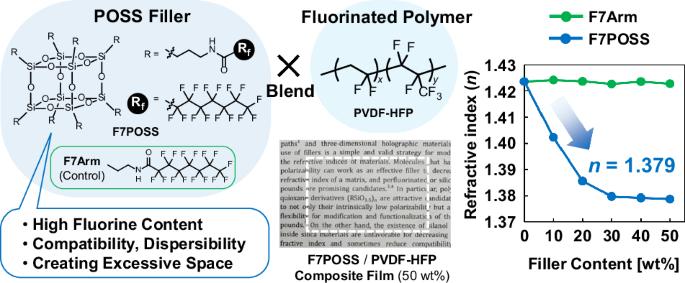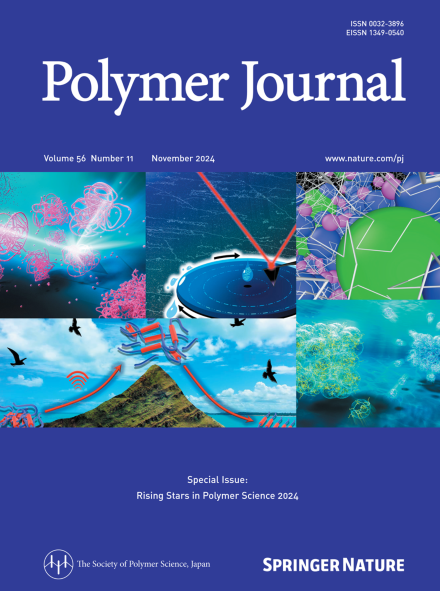用全氟烷基化POSS填料制备降低折射率的氟化聚合物复合材料
IF 2.7
4区 化学
Q3 POLYMER SCIENCE
引用次数: 0
摘要
在这项研究中,我们设计并合成了一种由多八面体低聚硅氧烷(POSS)核心和全氟烷基侧链组成的填料。我们发现,在含氟聚合物中掺入POSS填料可以有效地降低含氟聚合物薄膜的折射率。全氟烷基侧链增加了与氟化聚合物的相容性,POSS的树状结构在材料中创造了一个大的空间。利用填料系数(kp)定量评价填料的程度,将填料系数分解为两部分:含氟聚合物(kp,1)和POSS (kp,2)。由于POSS组分的填充系数小(kp,2 = 0.430-0.513),复合材料的折射率(n)从原始氟化聚合物的折射率(n = 1.424, kp,1 = 0.68-0.76)降至n = 1.379。这项研究是进一步降低目前实际使用的各种含氟聚合物折射率的一个里程碑。制备了PVDF-HFP和全氟烷基POSS (F7POSS)填料的氟化聚合物复合材料。随着POSS填料含量的增加,复合薄膜的折射率降低,热稳定性保持良好。利用洛伦兹-洛伦兹方程中的堆积系数定量评价了堆积程度。本文章由计算机程序翻译,如有差异,请以英文原文为准。

Fabrication of fluorinated polymer composite materials with a perfluoroalkylated POSS filler to reduce the refractive index
In this study, we designed and synthesized a filler comprising a polyoctahedral oligomeric silsesquioxane (POSS) core and perfluoroalkyl side chains. We found that by blending POSS fillers into a fluorinated polymer, the refractive indices of fluorinated polymer films can be efficiently lowered. The perfluoroalkyl side chains increase the compatibility with fluorinated polymers, and the dendrimer-like structure of POSS creates a large space in the material. The degree of packing was quantitatively evaluated by using the packing coefficient (kp), which was decomposed into two components: the fluorinated polymer (kp,1) and the POSS (kp,2). Owing to the small packing coefficient of the POSS component (kp,2 = 0.430–0.513), the refractive index (n) of the composite material decreased to n = 1.379 from that of the pristine fluorinated polymer (n = 1.424, kp,1 = 0.68–0.76). This study represents a milestone for further reducing the refractive indices of various fluorinated polymers currently in practical use. Fluorinated polymer composite materials of PVDF-HFP and a perfluoroalkylated POSS (F7POSS) filler were manufactured. The refractive indices of the resulting composite films decreased as the content of the POSS filler increased, and the thermal stability remained sufficient. The degree of packing was quantitatively evaluated by using the packing coefficient from the Lorentz–Lorenz equation.
求助全文
通过发布文献求助,成功后即可免费获取论文全文。
去求助
来源期刊

Polymer Journal
化学-高分子科学
CiteScore
5.60
自引率
7.10%
发文量
131
审稿时长
2.5 months
期刊介绍:
Polymer Journal promotes research from all aspects of polymer science from anywhere in the world and aims to provide an integrated platform for scientific communication that assists the advancement of polymer science and related fields. The journal publishes Original Articles, Notes, Short Communications and Reviews.
Subject areas and topics of particular interest within the journal''s scope include, but are not limited to, those listed below:
Polymer synthesis and reactions
Polymer structures
Physical properties of polymers
Polymer surface and interfaces
Functional polymers
Supramolecular polymers
Self-assembled materials
Biopolymers and bio-related polymer materials
Polymer engineering.
 求助内容:
求助内容: 应助结果提醒方式:
应助结果提醒方式:


